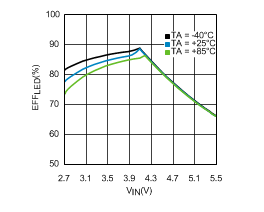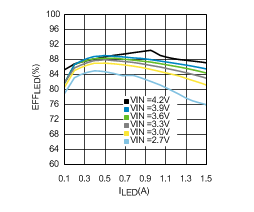SNVS796D August 2011 – October 2015 LM3556
PRODUCTION DATA.
- 1 Features
- 2 Applications
- 3 Description
- 4 Revision History
- 5 Pin Configuration And Functions
- 6 Specifications
-
7 Detailed Description
- 7.1 Overview
- 7.2 Functional Block Diagram
- 7.3 Feature Description
- 7.4 Device Functional Modes
- 7.5 Programming
- 7.6
Register Maps
- 7.6.1
Register Descriptions
- 7.6.1.1 Silicon Revision and Filter Time Register (0x00)
- 7.6.1.2 Input Voltage Flash Monitor (IVFM) Mode Register (0x01)
- 7.6.1.3 NTC Settings Register (0x02)
- 7.6.1.4 Indicator Ramp Time Indicator (0x03)
- 7.6.1.5 Indicator Blinking Register (0x04)
- 7.6.1.6 Indicator Period Count Register (0x05)
- 7.6.1.7 Torch Ramp Time Register (0x06)
- 7.6.1.8 Configuration Register (0x07)
- 7.6.1.9 Flash Features Register (0x08)
- 7.6.1.10 Current Control Register (0x09)
- 7.6.1.11 Enable Register (0x0A)
- 7.6.1.12 Flags Register (0x0B)
- 7.6.1
Register Descriptions
- 8 Application and Implementation
- 9 Power Supply Recommendations
- 10Layout
- 11Device And Documentation Support
- 12Mechanical, Packaging, And Orderable Information
8 Application and Implementation
NOTE
Information in the following applications sections is not part of the TI component specification, and TI does not warrant its accuracy or completeness. TI’s customers are responsible for determining suitability of components for their purposes. Customers should validate and test their design implementation to confirm system functionality.
8.1 Application Information
The LM3556 can drive one flash LED at currents up to 1.5 A. The 4-MHz DC-DC boost regulator allows for the use of small-value discrete external components.
8.2 Typical Application
 Figure 41. LM3556 Typical Application
Figure 41. LM3556 Typical Application
8.2.1 Design Requirements
Example requirements based on default register values are listed in Table 15:
Table 15. Design Parameters
| DESIGN PARAMETER | EXAMPLE VALUE |
|---|---|
| Input Voltage Range | 2.5 V to 5.5 V |
| Brightness Control | I2C Register |
| Output current | 1.5 A |
| LED Configuration | 1 Flash LED |
| Switching frequency | 4 MHz (typical) |
8.2.2 Detailed Design Procedure
8.2.2.1 Output Capacitor Selection
The LM3556 is designed to operate with a ceramic output capacitor of at least 10 µF. When the boost converter is running, the output capacitor supplies the load current during the boost converter's on-time. When the NMOS switch turns off, the inductor energy is discharged through the internal PMOS switch, supplying power to the load and restoring charge to the output capacitor. This causes a sag in the output voltage during the on-time and a rise in the output voltage during the off-time. The output capacitor is therefore chosen to limit the output ripple to an acceptable level depending on load current and input/output voltage differentials and also to ensure the converter remains stable.
Larger capacitors (for example, a 22-µF capacitor) or capacitors in parallel may be used if lower output voltage ripple is desired. To estimate the output voltage ripple, considering the ripple due to capacitor discharge (ΔVQ) and the ripple due to the capacitors equivalent series resistance (ESR) (ΔVESR), use Equation 1 and Equation 2.
For continuous conduction mode, the output voltage ripple due to the capacitor discharge is:

The output voltage ripple due to the ESR of the output capacitor is found by:

In ceramic capacitors the ESR is very low so the assumption is that 80% of the output voltage ripple is due to capacitor discharge and 20% from ESR. Table 16 lists different manufacturers for various output capacitors and their case sizes suitable for use with the LM3556.
8.2.2.2 Input Capacitor Selection
Choosing the correct size and type of input capacitor helps minimize the voltage ripple caused by the switching of the LM3556 device’s boost converter and reduces noise on the boost converter's input terminal that can feed through and disrupt internal analog signals. In the Figure 41 a 10-µF ceramic input capacitor works well. It is important to place the input capacitor as close as possible to the LM3556’s input (IN) pin. This reduces the series resistance and inductance that can inject noise into the device due to the input switching currents. Table 16 lists various input capacitors recommended for use with the LM3556.
Table 16. Recommended Input/Output Capacitors (X5R/X7R Dielectric)
| MANUFACTURER | PART NUMBER | VALUE | CASE SIZE | VOLTAGE RATING |
|---|---|---|---|---|
| TDK Corporation | C1608JB0J106M | 10 µF | 0603 (1.6 mm × 0.8 mm × 0.8 mm) | 6.3 V |
| TDK Corporation | C2012JB1A106M | 10 µF | 0805 (2 mm × 1.25 mm × 1.25 mm) | 10 V |
| Murata | GRM188R60J106M | 10 µF | 0603 (1.6 mm x 0.8 mm x 0.8 mm) | 6.3 V |
| Murata | GRM21BR61A106KE19 | 10 µF | 0805 (2 mm × 1.25 mm × 1.25 mm) | 10 V |
8.2.2.3 Inductor Selection
The LM3556 is designed to use a 1-µH or 0.47-µH inductor. Table 17 lists various inductors and their manufacturers that work well with the LM3556. When the device is boosting (VOUT > VIN) the inductor is typically the largest area of efficiency loss in the circuit. Therefore, choosing an inductor with the lowest possible series resistance is important. Additionally, the saturation rating of the inductor must be greater than the maximum operating peak current of the LM3556. This prevents excess efficiency loss that can occur with inductors that operate in saturation. For proper inductor operation and circuit performance, ensure that the inductor saturation and the peak current limit setting of the LM3556 are greater than IPEAK in Equation 3:

where
- ƒSW = 4 MHz
- Efficiency can be found in Typical Characteristics.
Table 17. Recommended Inductors
| MANUFACTURER | L | PART NUMBER | DIMENSIONS (L × W × H) | ISAT | RDC |
|---|---|---|---|---|---|
| TOKO | 1 µH | FDSD0312 | 3 mm x 3 mm x 1.2 mm | 4.5 A | 43 mΩ |
| TOKO | 1 µH | DFE252010C | 2.5 mm × 2 mm × 1 mm | 3.4 A | 60 mΩ |
| TOKO | 1 µH | DFE252012C | 2.5 mm × 2 mm × 1.2 mm | 3.8 A | 45 mΩ |
8.2.2.4 NTC Thermistor Selection
The TEMP pin is a comparator input for flash LED thermal sensing. NTC mode is intended to monitor an external thermistor which monitors LED temperature and prevents LED overheating. An internal comparator checks the voltage on the TEMP pin against the trip point programmed in the NTC Settings Register (0x02). The thermistor is driven by an internally regulated current source, and the voltage on the TEMP pin is related to the source current and the NTC resistance.
NTC thermistors have a temperature to resistance relationship of:

where
- β is given in the thermistor datasheet
- R25°C is the thermistor's value at 25°C.
8.2.3 Application Curves

| VLED = 3.6 V | ILED = 1.5 A | |

| VLED = 3.8 V | ||